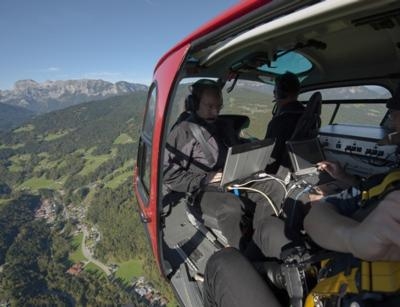Sat, Oct 27, 2012
Mission To Collect Data On How Two Different Systems Will Work Together
A helicopter recently flew over a very special Alpine valley to gather data on how Europe’s two satellite navigation systems – EGNOS and Galileo – will work together in future. The helicopter flew a variety of maneuvers, from fast loops to mid-air hovering, to see how satnav signals were received in practice. The results are now being analyzed.

The airborne testing, which took place in Germany in late September, was based around prototype signals of the next generation of the European Geostationary Navigation Overlay Service – EGNOS – combined with simulated Galileo signals. EGNOS, the first pan-European satellite navigation system, is based on U.S. GPS signals. The first four Galileo satellites have been placed in orbit – the minimum needed to provide basic navigational services. It will take many more to provide global coverage.
But there is one place in Europe where full Galileo service coverage is already a reality: the town of Berchtesgaden in the Bavarian Alps has transmitters atop eight neighbouring mountain peaks to blanket 65 sq km of territory with satnav signals. The result is the Galileo Test and Development Environment – GATE – a giant outdoor laboratory where prototype Galileo receivers can be used freely without any modifications.
Kept busy by European industrial and research teams, GATE is owned by the DLR German Aerospace Center. ESA’s Global Navigation Satellite Systems for Europe (GNSS) Evolution program uses it to help prepare the design of next-generation systems. The helicopter testing relied on the SPEED platform – Support Platform for EGNOS Evolutions & Demonstrations – enabling a user to receive simultaneous real-time augmentation signals for both GPS and Galileo, in the same way that the intended next-generation EGNOS system will operate.
The ESA-designed EGNOS employs a trio of satellites, processing facilities and a network of ground stations to improve the accuracy of GPS satnav signals over European territory. The service is guaranteed to an extremely high level of reliability set by the International Civil Aviation Organisation: it is allowed just a one in 10 million chance of error.

The satellite-based service provides horizontal and vertical guidance information for aircraft performing safety-critical landing approaches to airports in a similar way to existing Instrument Landing System devices – but with no local ground-based navigation infrastructure needed. “EGNOS is already certified for European aviation but what we are testing here is how it operates with Galileo,” explained Guenter Hein, head of ESA’s GNSS Evolution program. "We are seeking to develop the next generation of EGNOS, which should be ready and operational around 2020. The ambition for Europe is to have an EGNOS-like system able to manage the data coming from both Galileo and GPS, making the system much more robust. It will be an important part of a constellation of EGNOS-like satellite augmentation systems covering our entire planet.”
GNSS Evolution is also tasked with designing the next generation of more advanced Galileo satellites, proceeding on the basis that the first generation of satellites will need replacement in the course of the 2020s.
(Image provided by ESA)
More News
Airport Rotating Beacon A visual NAVAID operated at many airports. At civil airports, alternating white and green flashes indicate the location of the airport. At military airports>[...]
Aero Linx: Fly for the Culture Fly For the Culture, Inc. is a 501(c)(3) non-profit organization that serves young people interested in pursuing professions in the aviation industry>[...]
Klyde Is Having Some Issues Comprehending The Fed's Priorities FMI: www.klydemorris.com>[...]
Also: Viasat-uAvionix, UL94 Fuel Investigation, AF Materiel Command, NTSB Safety Alert Norges Luftsportforbund chose Aura Aero's little 2-seater in electric trim for their next gli>[...]
Also: EP Systems' Battery, Boeing SAF, Repeat TBM 960 Order, Japan Coast Guard H225 Buy Despite nearly 100 complaints totaling millions of dollars of potential fraud, combined with>[...]
 ANN's Daily Aero-Term (04.25.24): Airport Rotating Beacon
ANN's Daily Aero-Term (04.25.24): Airport Rotating Beacon ANN's Daily Aero-Linx (04.25.24)
ANN's Daily Aero-Linx (04.25.24) Klyde Morris (04.22.24)
Klyde Morris (04.22.24) Airborne 04.24.24: INTEGRAL E, Elixir USA, M700 RVSM
Airborne 04.24.24: INTEGRAL E, Elixir USA, M700 RVSM Airborne 04.22.24: Rotor X Worsens, Airport Fees 4 FNB?, USMC Drone Pilot
Airborne 04.22.24: Rotor X Worsens, Airport Fees 4 FNB?, USMC Drone Pilot




